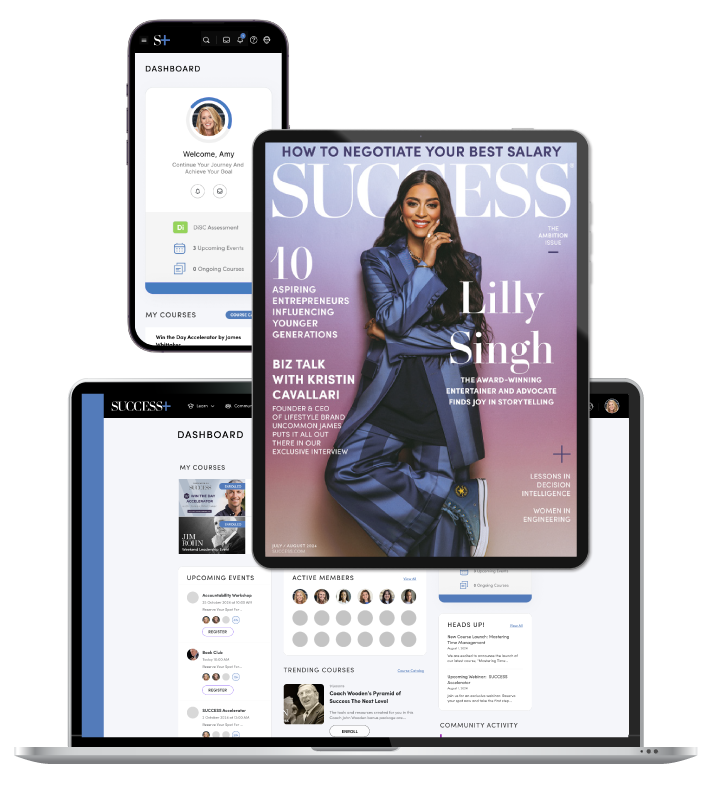
views
Quick Links
SECTIONS
- Business
- Entertainment
- Future of Work
- Health & Wellness
- Lifestyle
- Money
- Personal Development
- Professional Development
- Relationships
- SUCCESS Bestsellers
- Business
- Entertainment
- Future of Work
- Health & Wellness
- Lifestyle
- Money
- Personal Development
- Professional Development
- Relationships
- SUCCESS Bestsellers
JOIN US
- SUCCESS+
- SUCCESS Coaching
- Speakers Bureau
- SUCCESS Events
- SUCCESS Space
- Newsletter
- Daily SMS
- Subscribe
- Shop the SUCCESS Store
- SUCCESS+
- SUCCESS Coaching
- Speakers Bureau
- SUCCESS Events
- SUCCESS Space
- Newsletter
- Daily SMS
- Subscribe
- Shop the SUCCESS Store
GET IN TOUCH
CONNECT
Instagram Facebook Tiktok Linkedin Pinterest X-twitterMORE
 Get SUCCESS® Magazine PLUS 80+ Hours of Exclusive Training (& More!) to Multiply Your Earning Potential
SUBSCRIBE TODAY!
Get SUCCESS® Magazine PLUS 80+ Hours of Exclusive Training (& More!) to Multiply Your Earning Potential
SUBSCRIBE TODAY!
Save Up to 20% Before Oct. 2!
BOOKMARK Share TABLE OF CONTENTS
TABLE OF CONTENTS


You bought the planner, signed up for a task manager and met with a life coach. Still, you don’t feel like you’ve made any progress. How can you move forward in a way that lets you design your life how you want to? That’s where a Personal Development Plan (PDP) comes in.
A PDP isn’t just a tool; it’s a personalized strategy for achieving goals. By clarifying your ambitions and breaking them into actionable steps, you can turn aspirations into reality. If you want to improve your career or start a new one, a PDP can help. It can also help you learn a new skill or find balance in your busy life. A PDP gives you the clarity and focus you need to stay on track.
This guide will explain what a PDP is, help you explore its benefits and provide actionable steps to create one. By the end, you’ll have everything you need to design a plan that sets you up for lasting success.
In today’s fast-paced world, personal and professional growth often feel like an uphill battle. Balancing career advancement, self-improvement and life’s daily demands can leave you feeling directionless and overwhelmed. The global personal development market was estimated to be valued at around $43.77 billion in 2022—and projected to reach $67.02 billion by 2030. It’s clear the world is interested in self-improvement. But we don’t always know how to get started. This is where a Personal Development Plan can be beneficial.
A Personal Development Plan is a structured framework that helps you achieve both short- and long-term goals. It combines self-reflection, goal setting and strategic action to help you grow personally and professionally. Think of it as a detailed roadmap to reach your aspirations.
Unlike to-do lists, resolutions or general self-improvement, a PDP is specific, measurable and tailored to your unique circumstances. It allows you to assess your current state, define your desired outcomes and plan actionable steps.
A PDP helps you design your life, taking control of your journey through intentional living. Instead of moving from goal to goal without direction, think about your broader values and long-term objectives.
Creating a personal development plan offers a host of benefits, including:
Monitoring progress toward goals is a critical component that bridges the gap between goal-setting and attainment. Tracking improves performance when paired with feedback and strategies.
Understanding the core components of a PDP will help you get started creating your own. If your PDP includes these elements, you can ensure your plan is comprehensive and actionable:
To create a vision statement or set your vision, it can be helpful to reflect on your values, imagine your ideal future and write a vision statement. Here are some questions you can ask yourself when finding your vision:
When you’ve pondered these questions, you can begin crafting a concise, inspiring vision statement that represents your aspirations. For example: “I strive to be a thought leader in sustainable design, influencing positive change while maintaining a balanced and fulfilling personal life.”
While personal development is different from professional growth and development objectives, the two can complement one another.
Achieving goals requires clarity, perseverance and a solid strategy. Start by setting clear goals. Rather than vague aspirations, define specific, actionable objectives. This might involve breaking down larger goals into smaller, manageable steps.
Use the SMART Analysis Template to help with goals. The meaning of SMART in the context of goals refers to Specific, Measurable, Achievable, Relevant and Time-Bound. Instead of saying, “I want to get fit,” you can be more specific. You could say, “I want to lose 10 pounds in three months. I plan to exercise four times a week.”
Your vision and goals need to be followed by action to make them happen. For example, if you want to earn a professional certification, you need to take some steps toward obtaining it. First, research the certifications available. Next, enroll in a course that fits your needs. Then, study for two hours each day. Finally, take the exam by the deadline. By setting these milestones, you can celebrate progress—further motivating you to reach your overall goal.
To identify these resources, list what could help you reach your goals. This could be mentors, colleagues, friends, apps, books, networking groups, etc. Also, leverage technology and seek help when needed.
A timeline adds structure and accountability to your PDP. To create an effective timeline, define your start and end dates, set checkpoints and use visual tools. (Gantt charts, spreadsheets or task management apps like Asana can be helpful).
Take the time to assess if you are meeting your deadlines, where you’ve made progress and if your goals are still aligned with your vision. Reflect on successes and challenges. Don’t forget to be flexible—goals and circumstances change.
These components work together to create a plan tailored to your unique circumstances. Now let’s get into the step-by-step process for each of the above components of a personal development plan.
Creating a PDP might feel overwhelming. However, identifying the key elements is half the battle. Now let’s break it down into simple steps.
A strong plan begins with understanding yourself. Self-reflection is essential for identifying your strengths, weaknesses, values and ambitions.
Action Step: Use a journal or the SWOT analysis template to document your findings. A SWOT assessment helps evaluate your strengths, weaknesses, opportunities and threats. Start by listing your strengths—skills, talents or personal attributes that set you apart. Next, identify your weaknesses, or areas where you need improvement.
Goal-setting is the foundation of a PDP. Without clear objectives, it’s hard to measure progress. Use the SMART framework for goals that are:
Tip: Self-discipline is essential for reaching your goals. Building discipline starts with setting small, attainable goals. These smaller wins build confidence and momentum toward larger objectives.
Once you’ve set your goals, break them down into smaller, actionable tasks. This makes large objectives more manageable and prevents overwhelm.
Example: My goal is to enhance my public speaking skills.
These are some of the actionable steps you can take to reach that goal:
Tip: Meeting your goals may mean new behavioral innovations or the power of habit to make changes. This could include things such as habit tracking, positive reinforcement or mindset shifts. Identifying key habits that support your objectives and staying consistent with them can help you move toward your goals.
Achieving your goals often requires external support. Tap into resources that can help you succeed, such as:
For example, if you’re working on professional growth, a LinkedIn Learning subscription might provide industry-specific skills to keep you competitive.
Tracking progress is essential to stay motivated and ensure you’re on the right path. Use tools like goal-tracking apps, spreadsheets or bullet journals.
Pro Tip: Regularly review your progress. Set aside time weekly or monthly to reflect on what’s working and what isn’t. Adjust your plan as needed to stay on track.
Personal development is a dynamic process. What works today might need adjustment tomorrow. Revisit your PDP regularly to ensure it aligns with your evolving goals and circumstances.
Ask yourself:
Adjusting your plan allows you to remain flexible while staying focused on long-term growth.
To help inspire your plan, here are a few examples of actionable goals:
Goal: Gain a promotion within the next year.
Steps:
Pro Tip: Track your progress with a timeline and regularly update your supervisor on your career goals. This demonstrates initiative and keeps you top-of-mind for new opportunities.
Goal: Improve overall fitness
Steps:
Pro Tip: Pair your fitness goal with a wellness goal, such as improving sleep quality or reducing stress through meditation, to maximize your overall health.
Goal: Save $10,000 in the next 12 months
Steps:
Pro Tip: Set up a visual tracker, like a progress bar or chart, to see how close you are to reaching your $10,000 goal. Visualizing progress can keep you motivated.
Goal: Strengthen connections with loved ones
Steps:
Pro Tip: Plan occasional surprises, such as handwritten notes or small thoughtful gestures, to show appreciation for your loved ones.
Creating a Personal Development Plan is one of the most empowering steps you can take toward a fulfilling life. By committing to self-reflection, setting clear goals and taking actionable steps, you can transform your aspirations into achievements.
Remember, a PDP isn’t a one-time task; it’s a living document that evolves with you. Regularly review your progress, adapt your plan and celebrate your milestones.
Start small, stay consistent and watch as your personal development plan guides you toward a more purposeful and successful life.
Personal development focuses on self-improvement areas such as habits, mindset and lifestyle. Professional development targets career-related skills like leadership, technical expertise or networking. A comprehensive PDP can encompass both.
Review your plan every three to six months. Adjust goals as your circumstances or priorities change.
Absolutely! A PDP helps you align your goals with your values, ensuring you meet both personal and professional aspirations.
Tools like SWOT analysis templates, goal-tracking apps (e.g., Asana, Trello) and habit trackers can simplify the process.
Set small, achievable milestones and celebrate progress. Tracking accomplishments and seeking accountability through a mentor or group can also help.
This article was updated January 2025. Photo courtesy of mimagephotography/Shutterstock
5473 Blair Road, Suite 100
PMB 30053
Dallas, TX 75231
Copyright © 2025 SUCCESS Magazine. All rights reserved.
Save Up to 20% Before Oct. 2!
Copyright © 2024 SUCCESS Magazine. All rights reserved.
Unlock the Latest Knowledge that Can You Help You Achieve More in Life with More Confidence
Print and Digital Options Available
Oops!
You’ve reached your limit of free
articles for this month!
(plus get access to hundreds of resources designed
to help you excel in life and business)
Please enter your username or email address. You will receive an email message to log in.
No, thanks, I’m not interested in personal growth.
Plus, get access to daily inspiration, weekly newsletters and podcasts, and occasional updates from us.
By signing up you are also added to SUCCESS® emails. You can easily unsubscribe at anytime. By clicking above, you agree to our Privacy Policy and Terms of Use.
Please enter your username or email address. You will receive an email message to log in.
Get unlimited access to SUCCESS®
(+ a bunch of extras)! Learn more.
Please enter your username or email address. You will receive an email message to log in.
The exclusive article you’re trying to view is for subscribers only.
(plus get access to hundreds of resources designed
to help you excel in life and business)
Please enter your username or email address. You will receive an email message to log in.
https://www.success.com/personal-development-plan/























Comments
0 comment